#1st Kansas Colored Infantry
Text
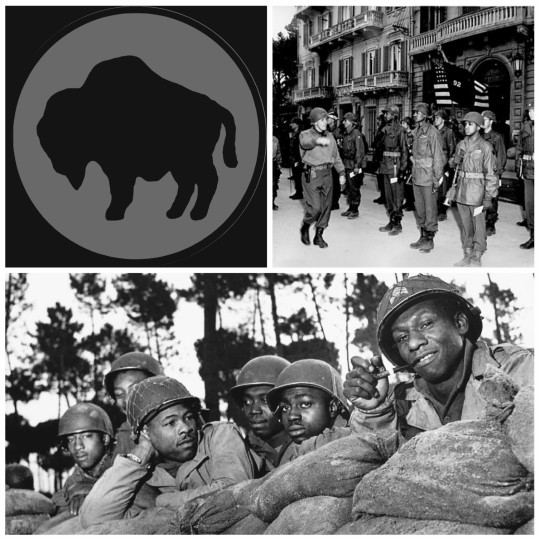
• 92nd Infantry Division
The 92nd Infantry Division was a segregated infantry division of the United States Army that served in both World War I and World War II. the American buffalo was selected as the divisional insignia due to the "Buffalo Soldiers" nickname, given to African American cavalrymen in the 19th century.
The 92nd Division was first constituted on paper October 24th, 1917 in the National Army, over six months after the U.S. entry into World War I. The division was commanded throughout most of its existence by Major General Charles C. Ballou and was composed of the 183rd Infantry Brigade with the 365th and 366th Infantry Regiments, and the 184th Infantry Brigade with the 367th and 368th Infantry Regiments, together with supporting artillery, engineer, medical and signal units attached. The division was organized on October 27th, 1917 at Camp Funston, Kansas. A special "negro zone" was to be built at the east end of Camp Funston, with "separate amusement places and exchanges." A.D. Jellison, a banker of Junction City, Kansas, gave a plot of land for a "community house," to be erected by the black men from the seven states which sent African-American trainees. As was the case with the 93rd Division, parts of the 92nd served under and alongside the French Army after both the main American Expeditionary Force, adhering to the racial policies of President Woodrow Wilson, Secretary of War Newton D. Baker, and southern Democrats who promoted the "separate but equal" doctrine, refused to allow African-American soldiers serve in combat with them. The 92nd Division saw combat in the Meuse-Argonne Offensive during November 1918.
The 92nd Infantry Divison was reactivated on October 15th, 1942, and was sent overseas on September 22nd, 1944. The division was reactivated as an infantry division with the "colored" designation, under the command of Major General Edward Almond, ten months after the American entry into World War II, at Fort Huachuca, Arizona and spent almost two years training in the United States. In late July 1944, the 370th Infantry Regiment was sent overseas to Italy and temporarily attached to the 1st Armored Division. The rest of the division would be sent overseas in September of that year, and the division as a whole would see heavy combat during the remainder of the Italian Campaign. During the 92nd Division's participation in the Italian Front, the Buffalo Soldiers made contact with units of many nationalities: beyond the attached 442nd Regimental Combat Team (442nd RCT), they also had contact with the colonial troops of the British and French colonial empires (Moroccans, Algerians, Senegalese, Indians, Gurkhas, Arab and Jewish Palestinians) as well as with exiled Poles, Greeks and Czechs, anti-fascist Italians and the troops of the Brazilian Expeditionary Force (FEB).
The division's commander, Major General Edward Almond, was for a time highly regarded by General George Marshall, the U.S. Army Chief of Staff, who was a fellow Virginia Military Institute (VMI) graduate. This was a major factor in Almond's promotion to major general and subsequent command of the division, a position he held from its formation in October 1942 until August 1945. He led the division in combat throughout the Italian Campaign of 1944–1945. Almond was chosen by General Marshall to command the division because he believed Almond would excel at what was seen as a difficult assignment. However, Almond performed poorly and went on to blame his poor performance on the fact that the division was made up of largely African American troops. He saw his troops as the source of his failure in combat, and went on to advise the army against ever again using African American soldiers as combat troops.
The 370th Regimental Combat Team, attached to the 1st Armored Division, arrived in Naples, Italy, August 1st, 1944 and entered combat on 24th. It participated in the crossing of the Arno River, the occupation of Lucca and the penetration of the Gothic Line. Enemy resistance was negligible in its area. As Task Force 92, elements of the 92nd attacked on the Ligurian coastal flank toward Massa, October 5th. By the 12th, the slight gains achieved were lost to counterattacks. Elements of the 92nd moved to the Serchio sector, November 3rd, 1944, and advanced in the Serchio River Valley against light resistance, but the attempt to capture Castelnuovo di Garfagnana did not succeed. Patrol activities continued until December 26th, when the enemy attacked, forcing units of the 92nd to withdraw. The attack ended on December 28th. The attacking forces were mainly from the Republic of Salò's Fascist Army, the 4th Italian "Monte Rosa" Alpine Division. After continuing poor combat performance including many instances of unauthorized withdrawals upon meeting the enemy, low morale and malingering, the 92nd Infantry Division was considered of inferior quality both by German and U.S. commands and fit for only defensive roles. Things deteriorated to the point that the division was withdrawn from the lines and rebuilt in early 1945 with the removal of the 366th Infantry Regiment (formed into two engineer general service regiments) and the addition of the 473rd and 442nd Infantry Regiments.Many historians have begun to reevaluate the combat record of the 92nd Infantry Division as contemporaneous reports of its honorable performance have continued to surface. Numerous veterans of the division believed that the reports of poor performance were motivated by racist sentiments present within the senior officer ranks. Even as evidence mounts in support of the division's honorable conduct, some still seek to suppress these facts. The famous and highly decorated Nisei 442nd, made up of Japanese Americans, was withdrawn from the fighting in France to bolster the division's combat effectiveness. The 365th and 371st Infantry Regiments became training and security regiments, respectively, and were stationed in rear areas, although still nominally assigned to the division. On April 1st, the 370th RCT and the attached 442nd Regimental Combat Team (Nisei) attacked the Ligurian coastal sector and drove rapidly north against light opposition from the German 148th Infantry Division, which was supported only by Italian coastal units. The 370th took over the Serchio sector and pursued the retreating enemy from April 18th until the collapse of all enemy forces on April 29th, 1945. Elements of the 92nd Infantry Division entered La Spezia and Genoa on 27th and took over selected towns along the Ligurian coast until the enemy surrendered on May 2nd, 1945 when all German forces in Italy surrendered.
The numbers alone tell an impressive story. Of 12,846 Buffalo Soldiers who saw action, 2,848 were killed, captured or wounded. The Buffalo Soldiers did, in fact, break through the Gothic Line. They reached their objective, captured or helped to capture nearly 24,000 prisoners and received more than 12,000 decorations and citations for their gallantry in combat. The soldiers of the 92nd Infantry Division had proved their worth to America once again through months of bitter combat in the Italian Campaign. Two members of the 92nd Infantry Division were medal of honor recipients John R. Fox, and Vernon J. Baker. The Medal of Honor was not awarded to these recipients until 1997. The 92nd Infantry Division was the only African American infantry division to see combat in Europe during World War II, as part of the U.S. Fifth Army, fighting in the Italian Campaign.
#second world war#world war ii#world war 2#wwii#military history#history#american history#black history matters#black history#black soldiers#black history month#infantry units#u.s infantry#italy in ww2
80 notes
·
View notes
Text

Among the missing stories fromt Oklahoma and it pre-staehood history are the stories of slavery, the quest for freedom and the stories of the Freedmen. Embedded in the quest for freedom comes the story of men both enslaved and free, who enlisted in the Union Army during the Civil War. This untold Oklahoma story is rich reflecting stories of courageous of these black freedom fighters who joined the battle for freedom. They are honored this week during Freedmen History Month
Almost 200,000 men of African descent served in the American Civil War. Within that large number were men who served in several portions of the Union Army--the United States Colored Troops, the Indian Home Guards and the 1st & 2nd Kansas Colored.
Within these units were men who had a background that distinguishes them from other soldiers. These men had lived in Indian Territory, within Five native tribes. Many had been slaves while in these tribes, and some or their parents had come to the Territory on the forced migration known widely as the Trail of Tears. The tribes from which they came are Cherokee, Choctaw, Chickasaw, Creek and Seminole Nations.
Many of these men have their names inscribed on the Civil War monument in Washington DC. Their participation in the Civil War is not widely known, even by many who descend from them. However, their legacy is a strong one, and as a result they are to be honored throughout this week, of Freedmen History month.
The Regiments in Which They Served
1st Indian Home Guards
2nd Indian Home Guards
3rd Indian Home Guards
1st Kansas Colored Infantry
2nd Kansas Colored Infantry
11th US Colored Infantry
54th US Colored Infantry
79th US Colored Infantry
83rd US Colored Infantry
Battles in Which They Fought
Baxter Springs, October 6, 1863 Kansas 2nd US Kansas Colored Infantry
Boggs Mills, January 11, 1864 Arkansas 11th US Colored Infantry
Cabin Creek, Cherokee Nation July 1-2 1863 and Nov 4,1865 2nd Kansas Colored, & 83rd US Colored Infantry
Clarksville January 18th 1865 79th US Colored Infantry
Cow Creek, Kansas November 14th 1864 54th US Colored Infantry
Ft. Gibson, September 16,1864 79th US Colored Infantry
Horse Head Creek Arkansas February 17, 1864 79th US Colored Infantry
Honey Springs July 17m 1864 1st Kansas Colored Infantry
Island Mound, Missouri October 27th & 29th 1862 1st Kansas Colored Infantry
Jenkins Ferry Arkansas April 30th 1864 83rd US Colored Infantry
Lawrence Kansas July 27th 1869 79th US Colored Infantry
Lotus Steamer (near Dardanelle) Jan 16, 1865 83rd US Colored Infantry
Poison Springs Arkansas April 18th 1864 1st Kansas Colored Infantry
Prairie D'Ann April 13th 1864 1st & 2nd Kansas Colored Infantries
Timber Hills, November 19th 1864 1st Kansas Colored Infantry
May the forgotten freedom fighters from Indian Territory long be remembered. Their legacy should no longer be overlooked.
4 notes
·
View notes
Text
On This Day...
1775 – The Olive Branch Petition, adopted by the Second Continental Congress on July 5, 1775, was signed by members of the Continental Congress. The petition was a final attempt to avoid a full-blown war between the Thirteen Colonies that the Congress represented, and Great Britain. The petition affirmed American loyalty to Great Britain and entreated the king to prevent further conflict. In August 1775 the colonies were formally declared to be in rebellion by the Proclamation of Rebellion, and the petition was rejected in fact, although not having been received by the king before declaring the Congress-supporting colonists traitors.
1776 – In Philadelphia, the Liberty Bell rings out from the tower of the Pennsylvania State House (now known as Independence Hall), summoning citizens to the first public reading of the Declaration of Independence, by Colonel John Nixon. On July 4, the historic document was adopted by delegates to the Continental Congress meeting in the State House. However, the Liberty Bell, which bore the apt biblical quotation, “Proclaim Liberty Throughout All the Land unto All the Inhabitants Thereof,” was not rung until the Declaration of Independence returned from the printer on July 8. In 1751, to commemorate the 50-year anniversary of Pennsylvania’s original constitution, the Pennsylvania Provincial Assembly ordered the 2,000-pound copper and tin bell constructed. After being cracked during a test, and then recast twice, the bell was hung from the State House steeple in June 1753. Rung to call the Pennsylvania Assembly together and to summon people for special announcements and events, it was also rung on important occasions, such as when King George III ascended to the throne in 1761 and to call the people together to discuss Parliament’s controversial Stamp Act of 1765. With the outbreak of the American Revolution in April 1775, the bell was rung to announce the battles of Lexington and Concord. Its most famous tolling was on July 8, 1776, when it summoned Philadelphia citizens for the first reading of the Declaration of Independence. As the British advanced toward Philadelphia in the fall of 1777, the bell was removed from the city and hidden in Allentown to save it from being melted down by the British and used for cannons. After the British defeat in 1781, the bell was returned to Philadelphia, which was the nation’s capital from 1790 to 1800. In addition to marking important events, the bell tolled annually to celebrate George Washington’s birthday on February 22, and Independence Day on July 4. In 1839, the name “Liberty Bell” was first coined in a poem in an abolitionist pamphlet. The question of when the Liberty Bell acquired its famous fracture has been the subject of a good deal of historical dispute. In the most commonly accepted account, the bell suffered a major break while tolling for the funeral of the chief justice of the United States, John Marshall, in 1835, and in 1846 the crack expanded to its present size while in use to mark Washington’s birthday. After that date, it was regarded as unsuitable for ringing, but it was still ceremoniously tapped on occasion to commemorate important events. On June 6, 1944, when Allied forces invaded France, the sound of the bell’s dulled ring was broadcast by radio across the United States. In 1976, the Liberty Bell was moved to a new pavilion about 100 yards from Independence Hall in preparation for America’s bicentennial celebrations.
1778 – George Washington headquartered his Continental Army at West Point.
1918 – Ernest Hemingway is severely wounded while carrying a companion to safety on the Austro-Italian front during World War I. Hemingway, working as a Red Cross ambulance driver, was decorated for his heroism and sent home. Hemingway was born in 1899 in Oak Park, Illinois. Before joining the Red Cross, he worked as a reporter for the Kansas City Star. After the war, he married the wealthy Hadley Richardson. The couple moved to Paris, where they met other American expatriate writers, including F. Scott Fitzgerald, Gertrude Stein, and Ezra Pound. With their help and encouragement, Hemingway published his first book of short stories, in the U.S. in 1925, followed by the well-received The Sun Also Rises in 1926. Hemingway would marry three more times, and his romantic and sporting epics would be followed almost as closely as his writing. During the 1930s and ’40s, the hard-drinking Hemingway lived in Key West and then in Cuba while continuing to travel widely. He wrote The Old Man and the Sea in 1952, his first major literary work in nearly a decade. The book won the Pulitzer Prize in 1953. The same year, Hemingway was wounded in a plane crash, after which he became increasingly anxious and depressed. Like his father, he eventually committed suicide, shooting himself in 1961 in his home in Idaho.
(Ernest Hemingway on crutches in 1918, outside the American Red Cross hospital in Milan. The protagonist in his World War I novel, A Farewell to Arms, is an American ambulance driver on the Italian front who was wounded in both legs.)
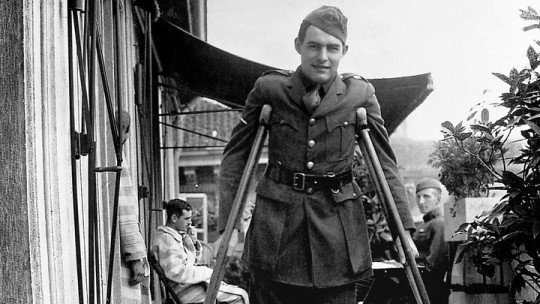
1944 – The US 1st Army is reinforced with 2 divisions arriving from Britain. There is heavy fighting along the road from Carentan to Periers.
1947 – In New Mexico the Roswell Daily Record reported the military’s capture of a flying saucer. It became know as the Roswell Incident. Officials later called the debris a “harmless, high-altitude weather balloon. In 1994 the Air Force released a report saying the wreckage was part of a device used to spy on the Soviets.
1959 – Maj. Dale R. Ruis and Master Sgt. Chester M. Ovnand become the first Americans killed in the American phase of the Vietnam War when guerrillas strike a Military Assistance Advisory Group (MAAG) compound in Bien Hoa, 20 miles northeast of Saigon. The group had arrived in South Vietnam on November 1, 1955, to provide military assistance. The organization consisted of U.S. Army, Navy, Air Force, and Marine Corps personnel who provided advice and assistance to the Ministry of Defense, Joint General Staff, corps and division commanders, training centers, and province and district headquarters.
1960 – The Soviet Union charged Francis Gary Powers, whose U-2 spy plane was shot down over the country, with espionage.
1999 – An Air Force cargo jet took off from Seattle on a dangerous mission to Antarctica to drop medicine for Dr. Jerri Nielsen, a physician at the Amundsen-Scott South Pole Research Center who had discovered a lump in her breast. The mission was successful; Nielsen was evacuated the following October.
Congressional Medal of Honor Citations for Actions Taken This Day
CARNEY, WILLIAM H.
Rank and organization: Sergeant, Company C, 54th Massachusetts Colored Infantry. Place and date: At Fort Wagner, S.C., 18 July 1863. Entered service at: New Bedford, Mass. Birth: Norfolk, Va. Date of issue: 23 May 1900. Citation: When the color sergeant was shot down, this soldier grasped the flag, led the way to the parapet, and planted the colors thereon. When the troops fell back he brought off the flag, under a fierce fire in which he was twice severely wounded.
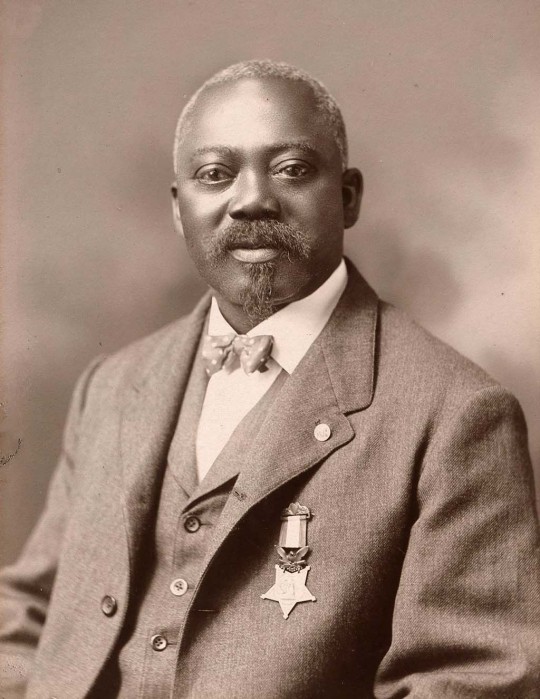
CO-RUX-TE-CHOD-ISH (Mad Bear)
Rank and organization: Sergeant, Pawnee Scouts, U.S. Army. Place and date: At Republican River, Kans., 8 July 1869. Entered service at: ——. Birth: Nebraska. Date of issue: 24 August 1869. Citation: Ran out from the command in pursuit of a dismounted Indian; was shot down and badly wounded by a bullet from his own command.
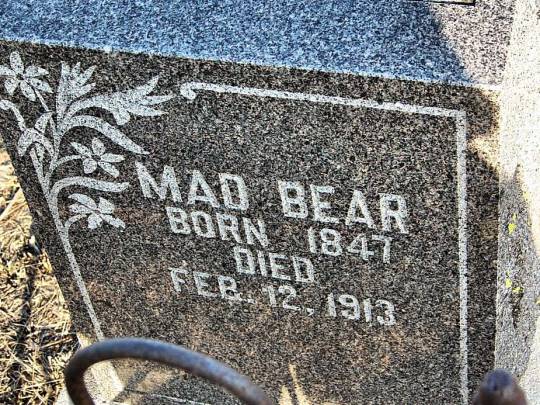
SHEA, RICHARD T., JR.
Rank and organization: First Lieutenant, U.S. Army, Company A 17th Infantry Regiment, 7th Infantry Division. Place and date: Near Sokkogae, Korea, 6 to 8 July 1953. Entered service at: Portsmouth, Va. Born: 3 January 1927, Portsmouth, Va. G.O. No.: 38, 8 June 1955. Citation: 1st Lt. Shea, executive officer, Company A, distinguished himself by conspicuous gallantry and indomitable courage above and beyond the call of duty in action against the enemy. On the night of 6 July, he was supervising the reinforcement of defensive positions when the enemy attacked with great numerical superiority. Voluntarily proceeding to the area most threatened, he organized and led a counterattack and, in the bitter fighting which ensued, closed with and killed 2 hostile soldiers with his trench knife. Calmly moving among the men, checking positions, steadying and urging the troops to hold firm, he fought side by side with them throughout the night. Despite heavy losses, the hostile force pressed the assault with determination, and at dawn made an all-out attempt to overrun friendly elements. Charging forward to meet the challenge, 1st Lt. Shea and his gallant men drove back the hostile troops. Elements of Company G joined the defense on the afternoon of 7 July, having lost key personnel through casualties. Immediately integrating these troops into his unit, 1st Lt. Shea rallied a group of 20 men and again charged the enemy. Although wounded in this action, he refused evacuation and continued to lead the counterattack. When the assaulting element was pinned down by heavy machine gun fire, he personally rushed the emplacement and, firing his carbine and lobbing grenades with deadly accuracy, neutralized the weapon and killed 3 of the enemy. With forceful leadership and by his heroic example, 1st Lt. Shea coordinated and directed a holding action throughout the night and the following morning. On 8 July, the enemy attacked again. Despite additional wounds, he launched a determined counterattack and was last seen in close hand-to-hand combat with the enemy. 1st Lt. Shea’s inspirational leadership and unflinching courage set an illustrious example of valor to the men of his regiment, reflecting lasting glory upon himself and upholding the noble traditions of the military service.

SOURCE
10 notes
·
View notes
Text
Summary Statement, 2nd Quarter, 1863 – Missing batteries
Earlier this week, I finished the transcription of the second quarter, 1863 summary statements with a pair of entries for California under the “Miscellaneous” heading. In the past, I’ve given my own “miscellaneous” listing to cover batteries which were not mentioned in the summary. But since the clerks of 1863 have secured that heading, I’ll have to consider other options.
For this quarter, with…
View On WordPress
#11th Michigan Battery#11th New York Heavy Artillery#12th Michigan Battery#13th Massachusetts Battery#15th Massachusetts Battery#1st Arkansas (Union) Battery#1st Colorado Battery#1st Connecticut Heavy Artillery#1st Kansas Colored Infantry#2nd Kentucky Battery#3rd Kentucky Battery#Albert F. Brooker#Armstrong&039;s Kansas Battery#Battery B 1st Connecticut Heavy#Battery M 1st Connecticut Heavy#Colvin&039;s Independent Illinois Artillery#Elgin Illinois Artillery#Franklin A. Pratt#Godwin&039;s Battery
0 notes
Photo
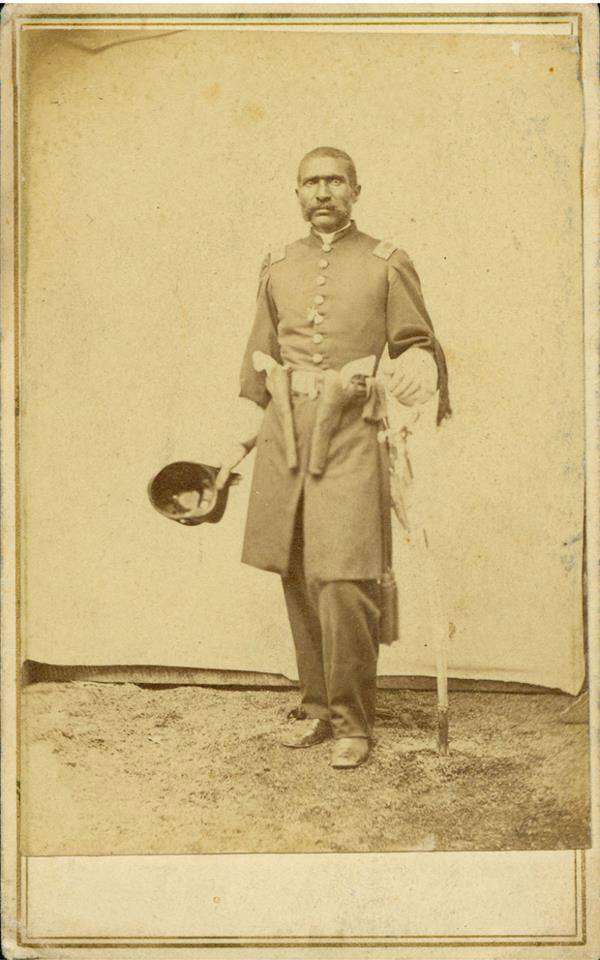
ANOTHER RARE IMAGE OF A SOLDIER WHO FOUGHT DURING THE CIVIL WAR IN INDIAN TERRITORY
1st Lt. William D. Matthews, Independent Battery, U. S. Colored Light Artillery
William D. Matthews was born a Maryland slave, so information about his early years remains elusive. By 1854, Matthews was a Black pioneer in Leavenworth, Kansas, a stop on the Underground Railroad. He opened a restaurant that soon became the head station on the underground railway system, with Matthews the “general passenger traffic manager.” As a manager, he helped numerous runaways reach safety through the Leavenworth connection, and continued his underground work until he enlisted in the Union army on February 27, 1862.
Between August 17 and November 25, 1862, Matthews recruited a company of 81 men for the 1st Kansas Colored Volunteer Infantry. Because the state of Kansas had not officially authorized the recruitment of Colored troops, they could not be mustered into service, and therefore received no pay. In January 1863, the regiment was officially reorganized and mustered into service at Fort Scott, Kansas.
William D. Matthews mustered into the Federal service on July 7, 1864, as a second lieutenant in the Independent Battery, U. S. Colored Light Artillery at Fort Leavenworth, Kansas, becoming one of the 120 African-Americans commissioned as officers during the Civil War. He was promoted to first lieutenant on February 27, 1865, and assumed command of the battery when its captain became ill. He was mustered out of service on July 15, 1865.
Image and info courtesy KansasMemory.org
18 notes
·
View notes
Text
Black Patriots: Heroes of the Civil War
Black Patriots: Heroes of the Civil War
This one-hour documentary takes viewers through an evolution of African American involvement over the course of the Civil War through the stories of some of the most crucial and significant figures of the day including Harriet Tubman, Robert Smalls, Frederick Douglass, the 1st Kansas Colored Volunteer Infantry Regiment, and the most celebrated regiment of black soldiers during the Civil War, the…
View On WordPress
0 notes
Photo
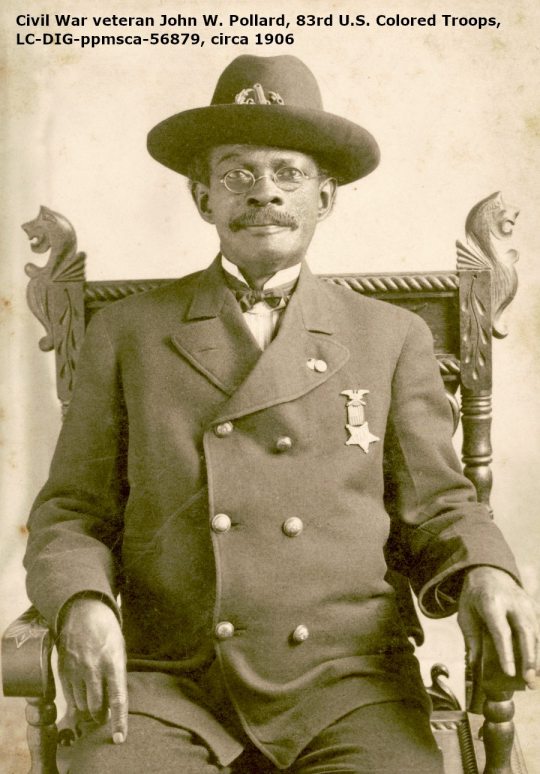
Union veteran John W. Pollard, formerly known as Jackson Ridgway or Wridgway, who had been an escaped slave.
A Family and Nation Under Fire, Kent State University Press
#iBooks https://goo.gl/SAVc8A
#nook https://goo.gl/DSQXGu
#Amazon: https://goo.gl/A3brGd
KSU http://goo.gl/Z3z4Xs
83rd Regiment, United States Colored Infantry was organized from 2nd Kansas Colored Infantry December 13, 1864. Attached to 2nd Brigade, District of the Frontier, 7th Corps, Dept. of Arkansas, to January, 1865. Colored Brigade, 7th Corps, Dept. of Arkansas, to February, 1865. 2nd Brigade, 1st Division, 7th Corps, Dept of Arkansas, to August, 1865. Dept. of Arkansas to October, 1865.
SERVICE: Duty at Fort Smith, Ark., till January, 1865. Moved to Little Rock, Ark., January 15-February 4, and duty there till August. Moved to Camden, Ark., August 1-10, and duty there till October 9. Mustered out October 9, 1865. Discharged at Leavenworth, Kansas, November 27, 1865. Regiment lost during service 2 Officers and 32 Enlisted men killed and mortally wounded and 211 Enlisted men by disease. Total 245. [Source: NPS Battle Unit Details https://www.nps.gov/civilwar/search-battle-units-detail.htm?battleUnitCode=UUS0083RI02C ]
0 notes
Photo
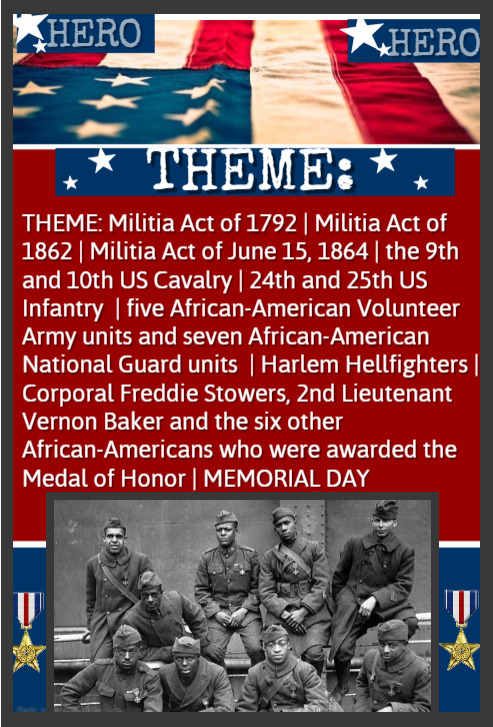
THEME: MILITIA ACT OF 1792 | MILITIA ACT OF 1862 - MILITIA ACT OF JUNE 15 1864 | THE 9TH AND 10TH US CAVALRY | 24TH AND 25TH US INFANTRY | FIVE AFRICAN-AMERICAN VOLUNTEER ARMY UNITS AND SEVEN AFRICAN-AMERICAN NATIONAL GUARD UNITS | HARLEM HELLFIGHTERS | CORPORAL FREDDIE STOWERS, 2ND LIEUTENANT VERNON BAKER AND THE SIX OTHER AFRICAN-AMERICANS WHO WERE AWARDED THE MEDAL OF HONOR | MEMORIAL DAY
Marines-"You can make use of Blacks and Mulattoes while you recruit, but you cannot enlist them." | The Militia Act of 1862, enacted July 17, 1862, was legislation that allowed African-Americans to participate as war laborers and soldiers for the first time to free up white men to be combat soldiers | On the Confederate side, blacks, both free and slave, were used for labor. In the final months of the war, the Confederate Army was desperate for additional soldiers so the Confederate Congress voted to recruit black troops for combat; they were to be promised their freedom. Units were in training when the war ended, and none served in combat. | Many black regiments struggled for equal pay, some refusing any money until June 15, 1864, when Congress granted equal pay for all black soldiers. | President James Madison "if his negroes would not run on the approach of the British?" replied: "No Sir…they don't know how to run; they will die by their guns first." | Volunteer Army:
7th United States Volunteer Infantry (Colored Troops)
8th United States Volunteer Infantry (Colored Troops)
9th United States Volunteer Infantry (Colored Troops)
10th United States Volunteer Infantry (Colored Troops)
11th United States Volunteer Infantry (Colored Troops)
National Guard:
3rd Alabama Volunteer Infantry (Colored Troops)
8th Illinois Volunteer Infantry (Colored Troops)
Companies A and B, 1st Indiana Volunteer Infantry (Colored Troops)
23rd Kansas Volunteer Infantry (Colored Troops)
3rd North Carolina Volunteer Infantry (Colored Troops)
9th Ohio Volunteer Infantry (Colored Troops)
6th Virginia Volunteer Infantry (Colored Troops)
Of these units, only the 9th U.S., 8th Illinois, and 23rd Kansas served outside the United States during the war. All three units served in Cuba and suffered no losses to combat
facebook.com/pg/IPlanetsAcademy/photos/?tab=album&album_id=2297259143914620
iPlanets Academy Pre-K Kindergarten Childcare Hybrid Homeschool Summer Camp Overnights Vacations Weekends Date Nights Mom's Day Out Shelter Foster Care
We are open 24 Hours to serve our families!
http://iPlanetsAcademy.com/
https://Facebook.com/iPlanetsAcademy
https://www.linkedin.com/in/iPlanetsAcademy
https://www.Twitter.com/iPlanetsAcademy
https://www.Pinterest.com/iPlanetsAcademy
#MimiRoss
#iPlanetsAcademy
#ChildCareNearMe
#DayCareNearMe
#PreKNearMe
#TuitionBasedPreK
#FamilyChildCare
#FamilyDayCare
#HomeChildCare
#HomeDayCare
#ChildCare
#Daycare
#DaycareTeacher
#ChildCareTeacher
#Homeschool
#HybridHomeschool
#HomeschoolPreschool
#HomeschoolMama
#HomeschoolMom
#Homeschoolers
#HomeschoolCoop
#HomeschoolTeacher
#HomeschoolCurriculum
#HomeschoolClasses
#SummerCamp
#OvernightCare
#WeekendCare
#Vacations
#MomDayOut
#DateNight
#PreschoolAtHome
#Preschool
#PreK
#PreKTeacher
#Kindergarten
#KindergartenTeacher
#FirstGrade
#FirstGradeTeacher
#1stgrade
#SecondGrade
#SecondGradeTeacher
#2ndGrade
#ThirdGrade
#ThirdGradeTeacher
#3rdGrade
#FourthGrade
#FourthGradeTeacher
#4thGrade
#FifthGrade
#FifthGradeTeacher
#5thGrade.
0 notes
Link
History tells us they charged through blood and fire so that the nation might live. However, at the time of their military service, they were not even recognized as citizens of the country they fought so valiantly to defend. They were the men who comprised the 1st Kansas Colored Infantry. Their regiment compiled a proud campaign record in Arkansas, Missouri, Kansas, and the Indian Territory during the Civil War.
from CBNNews.com https://ift.tt/2w90cXi
0 notes
Photo
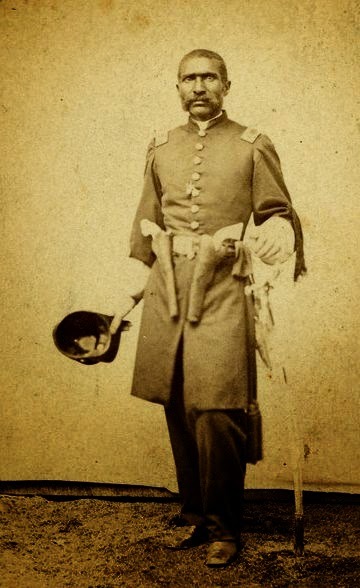
Lt. William Matthews, 1st Colored Kansas Infantry, American Civil War.
383 notes
·
View notes
Link
History tells us they charged through blood and fire so that the nation might live. However, at the time of their military service, they were not even recognized as citizens of the country they fought so valiantly to defend. They were the men who comprised the 1st Kansas Colored Infantry. Their regiment compiled a proud campaign record in Arkansas, Missouri, Kansas, and the Indian Territory during the Civil War.
from CBNNews.com https://ift.tt/2w90cXi
0 notes
Link
History tells us they charged through blood and fire so that the nation might live. However, at the time of their military service, they were not even recognized as citizens of the country they fought so valiantly to defend. They were the men who comprised the 1st Kansas Colored Infantry. Their regiment compiled a proud campaign record in Arkansas, Missouri, Kansas, and the Indian Territory during the Civil War.
from CBNNews.com https://ift.tt/2w90cXi
0 notes
Text
Summary Statement, 3rd Quarter, 1863 – Missing Batteries
Summary Statement, 3rd Quarter, 1863 – Missing Batteries
With the final entry for Wisconsin, I’ve presented all the sections from the Ordnance Summary Statements for the third quarter of 1863. Those covered equipment reported from “light” batteries, or any other unit reporting field artillery on hand. With any such accounting, and in particular during wartime, there will be gaps and missing information. When I started these summary statement…
View On WordPress
#107th Illinois Infantry#13th Kentucky Infantry#13th Massachusetts Artillery Battery#1st Florida (US) Battery#1st Florida (US) Cavalry#1st Kansas Colored Troops#1st Louisiana Light Artillery (AD)#2nd Louisiana Light Artillery (AD)#33rd Kentucky Infantry#35th New York Independent Battery#36th New York Independent Battery#3rd Louisiana Light Artillery (AD)#4th Iowa Battery#7th Maine Battery#80th Indiana Infantry#Armstrong&039;s Kansas Battery#Battery B 1st Connecticut Heavy Artillery#Battery M 1st Connecticut Heavy#Black River Bridge MS#Boyle&039;s Battery#Carl Adolf Lamberg#Chapin&039;s Battery New Jersey Militia#Charles S. Bowman#Crossly&039;s Half-Company (Delaware)#Fort Leavenworth#Fort Leavenworth Post Artillery#Hebron&039;s Plantation LA#Helena AR#Hurlbut&039;s Battery#Isaac B. Goodloe
0 notes
Photo

153 YEARS AGO -- SEPTEMBER 16, 1864 -- SEARCHING FOR THE WAGON TRAIN, THE RAGTAG CONFEDERATES ATTACK THE HAY CAMP AT FLAT ROCK
Gano and Watie's combined force attacks the hay camp located near Flat Rock, Indian Territory. Captain Edgar A. Barker, the Union officer in charge of the camp, decides to break through the Rebel lines in order to get word to Fort Gibson. He and his men of the 2nd Kansas Cavalry mount up and leave a detachment of black soldiers from the 1st Kansas Colored Infantry to their fate.
Led by Lt. David L. Sutherland, a white officer, the black soldiers hold off three separate charges before they are subdued. According to reports, all but four were killed. Sutherland spends the rest of the war as a prisoner at Camp Ford located near Tyler, Texas.
From his prisoners, Gano learns that the wagon train has not passed down the Texas Road. He writes a polite note to the Federal commander at Fort Gibson to come and bury his dead.
The Confederate brigadier general later wrote in his report to his superiors, "We rested on a field of blood."
The next morning, Gano takes 400 men and a section of Howell's battery to search for the wagon train. He and Watie would rendezvous after they found the train.
Photo: Artist's sketch showing the detachment of 1st Kansas Colored Infantry in a ravine on the battlefield at Flat Rock facing a Confederate attack. This sketch appears in the documentary "Last Raid at Cabin Creek" and is also published in the book "The Second Battle of Cabin Creek: Brilliant Victory."
4 notes
·
View notes
Link
History tells us they charged through blood and fire so that the nation might live. However, at the time of their military service, they were not even recognized as citizens of the country they fought so valiantly to defend. They were the men who comprised the 1st Kansas Colored Infantry. Their regiment compiled a proud campaign record in Arkansas, Missouri, Kansas, and the Indian Territory during the Civil War.
from CBNNews.com https://ift.tt/2w90cXi
via IFTTT
0 notes